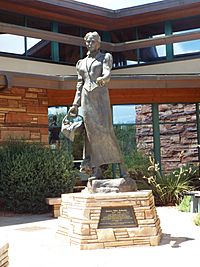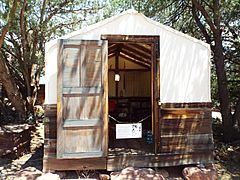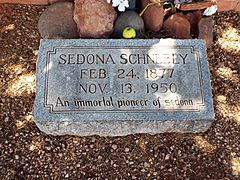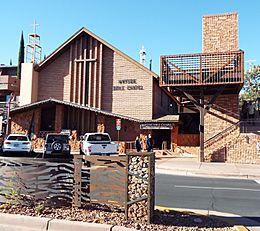Sedona Schnebly facts for kids
Sedona Schnebly (born Sedona Arabella Miller on February 24, 1877 – died November 13, 1950) was an important pioneer in the Oak Creek area of Arizona. She is famous because the town of Sedona, Arizona was named after her! Sedona helped set up her family's farm and general store. She also taught at the town's bible school. Sedona even saved money to help build the Wayside Chapel. Today, a statue of her stands in Sedona, honoring her memory.
Contents
Early Life and Family
Sedona was born in a town called Gorin, Missouri. Her parents were Philip and Amanda Miller. Her mother actually made up the name "Sedona"! But most people who knew her well called her "Dona" throughout her life.
Sedona went to Gorin Academy, where she got a good education. She learned languages and how to play the piano. After graduating, she taught for a short time. When she was 20, she met Theodore Carleton (T.C.) Schnebly. He was a smart young man who owned a hardware store with his brothers. They fell in love, but Sedona's parents didn't approve because of their different religions. The Millers were Methodist, and T.C. was Presbyterian.
Moving to Arizona
T.C. Schnebly's brother, Ellsworth, had already moved to the Oak Creek area in Arizona. His doctor had suggested it for his health. Ellsworth wrote to T.C. and Sedona, telling them how great Arizona was. He described lots of land, clear air, and plenty of animals and fish.
Ellsworth convinced them to move. When the Schneblys told Sedona's parents, they were very upset. This caused some problems between the families.
T.C. arrived in Oak Creek, which people called "red rock country," before Sedona and the children. He worked with other pioneers to build irrigation systems. They used ditches, flumes, and pipelines to move water. He bought 80 acres of land from Frank Owenby. This land, called Camp Garden, had an orchard along Oak Creek. T.C. started taking his farm goods to Flagstaff to sell them. Then he would bring supplies back to his farm.
T.C. sent for Sedona and their two children. She took a train with their belongings to the mining town of Jerome. T.C. met them there. He loaded his family and their things onto a wagon and headed to Oak Creek. They arrived at their new home on October 12, 1901. They built a two-story house and opened a small store. They sold their farm goods to people living nearby. The Schneblys even hired workers to build what is now called Schnebly Hill Road. This road made it much easier to take their crops to Flagstaff.
How Sedona Got Its Name
Their large house also became a place for visitors to stay. Guests paid only about $1 a day for a room and food. People who were sick with tuberculosis stayed in tent-houses on the property. Sedona was very busy! She cooked for everyone and took care of her children. She also helped on the farm, made soap, and canned fruits and vegetables.
The Schneblys believed their growing community needed a post office. T.C. wanted to be the first postmaster. He wrote to the Postmaster General in Washington, D.C.. He suggested names like "Oak Creek Crossing" and "Schnebly Station." But both names were too long and were turned down. T.C.'s brother, Ellsworth, then suggested the name "Sedona." On June 26, 1902, that name was approved! And that's how the town of Sedona got its name.
Family Challenges
On June 12, 1905, a sad event happened. Sedona's five-year-old daughter, Pearl, died in an accident with her pony. She was buried in the front yard of their home. Sedona became very sad after this. To help her feel better, the Schneblys moved back to Missouri for a while.
Sedona's husband, T.C., later decided he wanted to farm again. The family moved to Boyero, Colorado. They faced financial difficulties, and T.C.'s health got worse. His doctor suggested he return to Arizona for his health, so they did.
Back in Sedona
In 1930, they moved to Phoenix, but returned to Sedona that same year. Their old homestead was gone. They had to rent a small, one-room house on Jordan Road. T.C. helped Walter Jordan with his orchards and property. Sedona helped Ruth Jordan with cleaning, cooking, and taking care of their three children. She also washed and ironed uniforms for the Civilian Conservation Corps boys for 10 cents per shirt.
Sedona Schnebly taught Bible classes at the American Sunday School. She saved her own money to help build a religious chapel. In 1950, the Wayside Chapel was finished. It was built just off Highway 89A and dedicated to Sedona Schnebly. Sedona was battling cancer and passed away on November 13, 1950. Her husband, T.C., lived almost four more years, dying on March 13, 1954. Both Sedona and T.C. are buried in Cooks Cedar Glade Cemetery. Their daughter Pearl's remains were also moved there.
Legacy and Remembrance
On February 14, 2012, a special bell called the Sedona Schnebly Memorial bell was rung. This happened at 2:14 PM during Arizona's 100-year celebration of becoming a state. The bell ringing took place in front of the Wayside Chapel.
The Red Rock Quilters guild made a special quilt for Arizona's Centennial. It showed Sedona Schnebly picking apples with the famous red rocks of Sedona in the background.
To honor Sedona's memory, the Sedona Red Rocks Arts Council asked an artist to create a statue of her. The statue was made in 1994 by Susan Kliewer, a local artist. It was shown to the public on October 1, 1994, in front of the Sedona Public Library. This was the town's first "Art in Public Places" project. The plaque on the statue's base tells her story.
The town of Sedona also dedicated a garden to her, called the Sedona Schnebly Memorial Garden. You can find it at 260 Schnebly Hill Road.
See Also
- List of historic properties in Sedona, Arizona
- List of American places named after people
- Schnebly Hill Formation






